9+1 Greek islands to visit this summer
It’s been a year since the article ‘10 great Greek islands: readers’ travel tips’ was published in the Guardian. My tip ‘Hiking in Amorgos, Cyclades’ was not only included but it was also the winning tip.
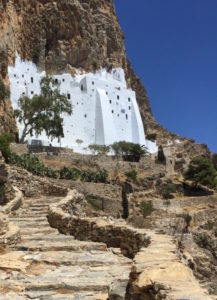
Since then, I have launched the Traveling Psychiatrist, a travel and wellbeing blog, where I publish weekly travel tips on my happy places (Greek islands, Norway, and London) and wellbeing tips based on my clinical experience and inspired by the books I read. An amateur cook and baker, sometimes, I’ve gone as far as to also share healthy recipes inspired by my travels, such as the orange pie (portokalopita) from Amorgos.
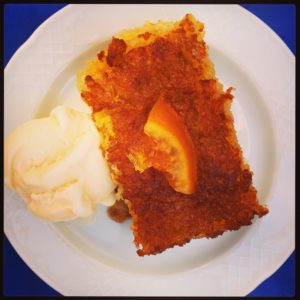
Further to popular demand, this week I’m going back to where it all started: the Greek islands. I’m sharing one tip for each of the 9 (+1) Greek islands I’ve visited in the last couple of years.
My e-book ‘Greek Islands: Top tips by an (almost) local’ is available for FREE for every new subscription (for a LIMITED TIME ONLY).
Hiking in Amorgos
(as published in the Guardian on 17th May 2018)
As well as the azure bays and its role in Luc Besson’s The Big Blue, Amorgos is also renowned for its hiking trails, which not only connect the island’s villages but also provide access to ecclesiastical and natural landmarks.
Start at Hora, the capital of the island, and walk towards the landmark of Amorgos, the Greek-Orthodox monastery of Panagia Hozoviotissa. Built by Byzantine emperor Alexius Comnenus I in the 11th century, this whitewashed monastery is wedged into a cliff face 300 meters above the sea. Climb the nearly 300 steps, walk through the low marble doorway and take the staircase that leads to the chapel where treasures and icons are kept. You will be rewarded with a vertiginous yet panoramic view of the Mediterranean, complimentary rose-flavored loukoumi (Greek Turkish delight) and psimeni raki (raki with honey and spices) offered by the monks.
From there, descend towards the pebble beach of Agia Anna. Here the waves splash against a rock which a chapel of the same name is built on. It’s then time to dive into the deep blue Aegean.
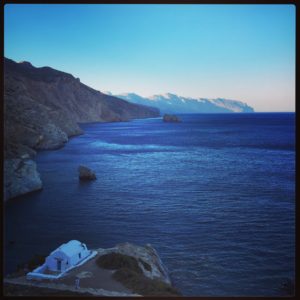
Kos: the island of Medicine
One of the best known Greek islands, Kos is a popular destination for the European holiday-makers. Yet, Kos has a rich history that is often overlooked; this is where Hippocrates, the Father of Medicine, began his medical career. Built upon the slopes of a hill about a couple of miles northwest of Kos Town, the Asclepieion overlooks the Aegean with the Turkish coast on the background. Although it dates back to the fourth century BC, the ruins were only unearthed about a hundred years ago, at the beginning of the twentieth century.
The myth
According to the ancient Greek myth, Asclepios was the first baby to have been delivered via -what centuries later came to be known as- Caesarean section. He was the son of Apollo, one of the twelve Olympian Gods, and Coronis, a mortal woman from mainland Greece. But, whilst pregnant with Asclepios, Coronis fell in love with another man, Ischys. To punish her, Apollo asked his sister, Artemis, to kill Coronis. Whilst burning, Apollo took pity of their unborn child, and cut her womb open. Asclepios had just been rescued.
Fast forward a few years later, Asclepios grew up to become a famous healer. Legend has it that he would go from town to town to cure people’s afflictions and diseases. He would even heal the deadly snakebite, which is how the rod with the snake became a symbol of Medicine. This, however, angered the Gods, who did not like the idea of a mortal curing the ill, reviving the dead, and generally interfering with the natural order of things. Asclepios simply had to die. So, Zeus struck him down with a thunderbolt.
Following his tragic death, however, people started worshipping him as a God. And, God he became. To honor him, temples were built across Greece. These temples were more than sanctuaries; they were also healing centers where people would go with the hope to get cured. And, of course, aspiring doctors would go there to learn the art of Medicine. Unsurprisingly, the most famous of these sanctuaries/healing centers, is the one in Kos.
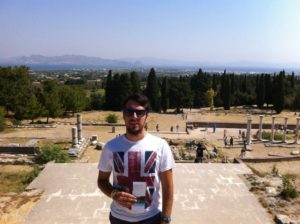
Skyros: the island of wellness and wellbeing
There are about 6,000 Greek islands of which 227 are inhabited. When people ask me which one is my favorite, or which one to visit (a frequently asked but rather difficult question to answer), Skyros is always the first to come to mind.
Skyros is a great place to unwind, relax and enjoy some peace and quiet. One may argue that most Greek islands are such places. True. However, there is a very good reason why Skyros tops that list. The island is home to Skyros Center, Europe’s first course-based holiday center, which is unsurprisingly included in the Wellness Escapes. Located in Atsitsa in the north-western part of the island, it is one of the 4 retreats in Greece featured in the Lonely Planet edition. Now in its 41st year, Skyros Center offers yoga, health and wellbeing retreats, but also art and writing courses.
Skyros is also a magnet for intellectuals, hippies, and hipsters for decades. The reason? Here lies the olive grove where the English poet Rupert Brooke was buried during the First World War, when the Tris Boukes bay was used as an anchorage for hospital ships treating the wounded from Gallipoli. A century later, the ‘Statue of an Ideal Poet’, erected in memory of the famous Englishman, stands tall high above the Aegean in a small square that bears his name. Also known as the ‘Square of Eternal Poetry’, it offers a panoramic view of the popular beaches of Magazia, Molos, and Gyrismata.
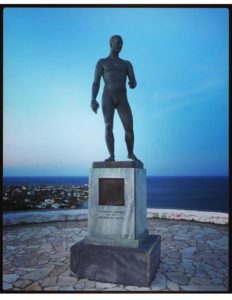
Santorini: the most iconic island
Probably the most iconic Greek island, Santorini (or Thira, as it is also known as) is the southernmost island of the Cyclades. One of the most famous as well as the most visited Greek islands, it can become quite hectic in the summer.
Get off the beaten track and go to the inland village of Pyrgos Kallistis (or simply Pyrgos), built amphitheatrically at the highest point of the island. You know what comes next: panoramic views of the whole island (not just the caldera) make this the perfect place to watch the sunset that Santorini is worldwide famous for. Stroll through the narrow, labyrinthine streets, and then experience the Greek hospitality and local cuisine at Penelope’s Ouzeri, a small traditional eatery, or at Brusco ‘wine. coffee. deli’.
Santorini is famous for delicious appetizers not normally found elsewhere in Greece. Try the ntomatokeftedes (tomato balls/fritters), the locally-produced cheese (hlorotyri), fava (yellow split-peas) and white eggplants. Locally-produced Santorini and Vinsanto wines are both made from the indigenous grape Assyrtiko; the latter is a sweet dessert wine.
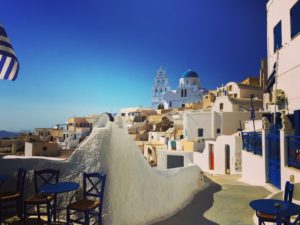
Folegandros: the secret alternative to Santorini
When I came across Jade Conroy’s article ‘the secret alternative to Santorini’ (published in the Telegraph on 22nd February), Folegandros immediately sprang to my mind. I was right.
One of the least known Greek islands, Folegandros is only an hour away (on the ferry) from the world-famous Santorini. This rather small Cycladic island is located in the southern Aegean Sea, nested between Milos and Kimolos on the west, and Sikinos and Ios on the east (Santorini is further on the east).
Whitewashed houses. Blushing bougainvilleas. Cobbled alleyways. Welcome to Hora, the charming inland capital of Folegandros. Built on the edge of a 200-meter high cliff, Hora is where the heart of the island beats. Ditch your map (if you have one) and simply wander around the village taking in the friendly atmosphere. Color-coded tables and chairs from the inviting taverns in the squares of the village provide a picture-perfect backdrop. Then, stroll around Kastro, the oldest part of Hora, before you make your way to the church of Panagia.
Dedicated to the Dormition of the Virgin Mary, this whitewashed church is the landmark of Folegandros. The ascending path is easy to climb (no more than 15 minutes from Hora), and it will reward you with panoramic views of the island. Evenings are the best time to visit, so you can watch the sunset.
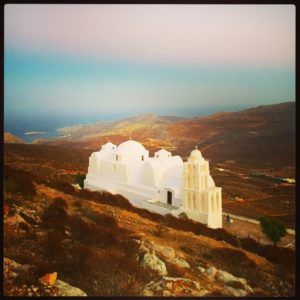
Koufonisia: the hidden gems of the Aegean
I have to admit that I had never heard of Koufonisia until a couple of years ago. Perhaps, this is because these three Cycladic islands are really really small. Actually, only one is inhabited: Ano (or Pano) Koufonisi (‘Upper Hollow Island’). Au contraire, Kato Koufonisi (‘Lower Hollow Island’) and Keros are not. Interestingly, when Greeks say ‘Koufonisia’, they usually refer to Ano Koufonisi, rather than all three. Despite their close proximity to Amorgos and Naxos, these tiny islands are considered remote and often described as ‘hidden gems’, ‘off the beaten track’ or ‘undiscovered paradise’, even for Greeks and Italians, who are the main visitors.
Hora is the island’s only village and spreads out behind the ferry quay. Wander along the main street towards the small harbor of Loutro, where you can have dinner at one of the seaside taverns.
Beach-hopping
From Hora, start walking anti-clockwise towards the beach of Pori; even though the distance from Hora to Pori is only 3.5 km, beach hopping is more of a day-long activity. First stop is Finikas, where a beach bar may tempt you to stay. Inviting as this may be, continue towards Fanos and Platia Pounta. The latter, also known as Italida, is a nudist beach; however, many prefer not to bare it all and still enjoy its golden sand and azure waters.
From Italida, walk along the cliff path towards Pori; you will pass by the small caves, one of the most famous sights of the island. Piscina (‘Pool’), or Devil’s Eye, is the one that attracts the biggest crowd – diving from the top of the cave into the naturally formed pool. Continue to Pori and then to the secluded by the caves ‘beach’ Gala. This is slightly tricky to find, as you can only see it once you are actually there.
At Pori, hop on a boat taxi back to Hora. Alternatively, you can walk along the inland road.
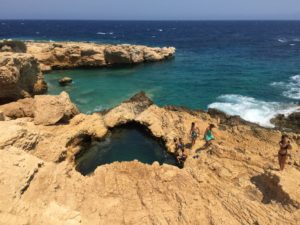
Serifos: the Greek island where time stands still
In June 2017, Kate Lough shared her ‘10 reasons why you should visit the Greek island of Serifos’. She wrote that she ‘found a Greece that seemed to have stood still since the 1960s and where island life remains unspoiled by mass tourism’. I visited Serifos a year later, in August 2018. Oblivious to Kate’s article at the time, I came to the same realization: Serifos reminded me of a Greece of a different era: it was the Greece that starred in the 1960s movies I used to watch as a child. Again and again, during my time on this small Greek island, the phrase ‘time stands still’ came to my mind.
Preparing for my trip, I had read that Serifos has over 70 beaches. Now, it’d be a blatant lie if I said I’d been to all of them. Making friends with the locals, however, saved me time and helped me decide which ones to visit. One of the most famous and my personal favorite is Agios Sostis. For this east-facing beach takes its name from the chapel overlooking the small bay. The beach is neither organized nor has any facilities (whether a beach bar, tavern or even a canteen); so make sure you bring a beach towel, a book, food, and water if you are to spend the day there.
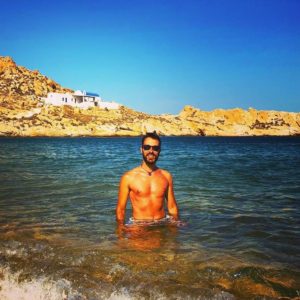
Sifnos: the island of Greek gastronomy
As a child growing in Greece, I would often hear the word ‘tselementes’ being used to refer to any cookbook. So, I naturally assumed that it meant ‘cookbook’. Not quite so. I later learned that Nikolaos Tselementes was a Greek chef and cookery writer born on the island of Sifnos in the late 19th century. 130 years later, this small Cycladic island is considered the capital of Greek gastronomy.
Fish and seafood play a protagonist role in the Cycladic cuisine; however, Sifnos is famous for a dish called ‘mastelo’: goat or lamb marinated in red wine and oven-cooked in ceramic pots made on the island.
Other local specialties include ‘revithada’ (a chickpea soup or stew), ‘revithokeftedes’ (chickpeas croquettes or fritters) and ‘kaparosalata’ (caper salad). Don’t forget to try the island’s cheese ‘manoura’, made from sheep and goat milk.
For dessert, try ‘melopita’ (honey pie) and ‘amygdalota’ (marzipan-based sweets).
If you love cooking, you could join a cooking course and make these delicious dishes from scratch using the freshest ingredients – locally sourced of course.
If you visit Sifnos in early September, you’ll come across the Cycladic Gastronomy Festival ‘Nikolaos Tselementes’. Taking place in Artemonas, it offers a unique opportunity to savor not only the local cuisine, but also dishes from other Greek islands. The festival is now in its 13th year and is free to attend.
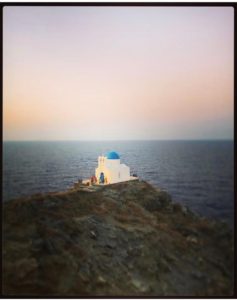
Mykonos: the hedonistic island
I have to admit that I had always thought Mykonos as little more than a party island destination and a celebrity-magnet. However, the first time I set foot on this Cycladic island, Hora, the capital and main settlement, simply took me by surprise. I remember wandering around the narrow, labyrinthine alleyways, taking pictures of cats napping, or of the blushing bougainvilleas climbing up the walls of the whitewashed houses, churches and chapels. Even though I am not religious, I was mesmerized by the Church of Panagia Paraportiani and the Life Giving Spring Orthodox Metropolitan Church.
There are a number of beaches on the island, but the famous ones (where the celebrities hang out and the beach parties take place) are on the south-west coast. Having a car and a more-than-average budget to spend will both come handy. Psarou, Paraga, Paradise and Super Paradise are the best-known and most expensive ones and they are all organized. Sunbeds may cost a small fortune, but the combination of crystalline waters, signature summer cocktails and luxurious atmosphere is compensation. Psarou is home to the renowned restaurant Nammos, whereas Super Paradise is home to JackieO’ Beach Club and Restaurant. Enjoy the dazzling turquoise waters, then join the party and dance till late.
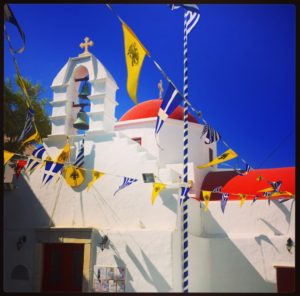
Delos: the sacred island
From Mykonos, go on a guided tour to the nearby, uninhabited island of Delos. The boat takes only half an hour; yet, it feels like thousand miles away from the buzz of Mykonos. The mythical birthplace of Apollo and Artemis, Delos is now a UNESCO World Heritage Site and one of the most important historical and archaeological sites in Greece.
This year, however, Delos is also home to 29 ‘bodyforms’ created by British contemporary sculptor Antony Gormley. These life-size sculptures have been installed across the island. Five of them have been commissioned specifically for this installation, which will be on display from 2nd May to 31st October 2019.
How to get to the Greek islands
Of the islands mentioned above, there are international and domestic flights to Kos, Santorini and Mykonos; there are also domestic flights to Skyros. It is worth considering flying to Athens (it’s always worth spending a few days there too), then taking the ferry or a domestic flight to the islands.
Check out the ferries timetable here. The Eurail Greek Islands Pass is worth considering.
When to visit the Greek islands
For me, the best time to visit the Greek islands is the summer; this is when the ferries are at their most frequent, the weather at its warmest and the atmosphere at its best. July and August are the best months. However, avoid late August when the winds get too strong.
Accommodation
Amorgos
Aegialis Hotel & Spa is the only five-star hotel on the island; it is located near the village and port of Aegiali on the northwest coast. Alternatively, you can stay in Katapola or in Hora.
Kos
The island of Kos is a relatively large one; the capital, Kos Town, is the best place to stay. Kos Aktis Art Hotel, is a boutique hotel perfectly located on the beachfront right in the center of Kos Town. Another option is the luxury hotel Aqua Blu Boutique Hotel & Spa, one of my favorite places to watch the sunset and enjoy a few cocktails, which is not far from Kos Town.
Skyros
Most hotels and rooms to rent are located in Molos or Gyrismata. During my last visit, I stayed at Nemire Luxury Residences in Molos, right by the sea. They include a villa, individual rooms to rent, and studios; they’re all self-catered and full with character.
Santorini
Accommodation in Santorini can be quite expensive. If your budget allows it, why not choose one of the 59 hotels with an infinity pool on the edge of the caldera. These are located on the west coast of the island (Oia, Fira, Imerovigli, Firostefani). Even if you cannot afford to stay in one of these luxurious hotels, I would strongly recommend you stay on the west coast.
Folegandros
Hora is the best place to stay; you could rent a room or a house/apartment there.
Koufonisia
Ever wished to sleep in an actual windmill? If yes, Windmill Villa is the place where you should stay. To avoid disappointment, book early, as there is only one apartment available to rent. It has to be rented for a minimum of three days and can sleep up to four people. Located very close to Hora, it is probably as unique an accommodation as you can get.
Serifos
Hotel Rizes and Coco-Mat Eco Residences stand out. Alternatively, rent a room or a house in Hora.
Sifnos
Apollonia is the most convenient place to stay; you could rent a room or a house/apartment there.
Mykonos
Mykonos is undoubtedly an expensive island to visit, and accommodation is no exception. If you can afford to treat yourself to a luxurious hotel, why not choose one of the 120 hotels with an infinity pool; these are scattered all over the island, but the majority are either on the west coast (where Hora and the New Port are) or on the south coast (where the beach parties are). Otherwise, stay as close to Hora as your budget allows.
Further reading on the Greek islands
To better prepare for my trip, I used the Lonely Planet Greek Islands Travel Guide
You can follow one of my two itineraries: Santorini-Amorgos-Koufonisia-Mykonos or Serifos-Sifnos-Folegandros-Santorini.
To follow my travels around the world, simply subscribe to the Traveling Psychiatrist (subscription button on the left-hand side).
My e-book ‘Greek Islands: Top tips by an (almost) local’ is available for FREE for every new subscription (for a LIMITED TIME ONLY).
‘Happy is the man, I thought, who, before dying, has the good fortune to sail the Aegean Sea.’
Nikos Kazantzakis, Greek writer
Have a great journey!
Alex
(the Traveling Psychiatrist)